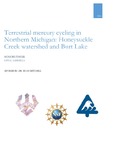Terrestrial Mercury Cycling in Northern Michigan: Honeysuckle Creek Watershed and Burt Lake (thesis)

View/
Author
Kitch, Gabriella D.
Subject
Washington and Lee University -- Honors in Geology
Water -- Pollution
Mercury -- Environmental aspects
Watershed ecology
Michigan
Metadata
Show full item recordDescription
Thesis; [FULL-TEXT FREELY AVAILABLE ONLINE] Gabriella D. Kitch is a member of the Class of 2016 of Washington and Lee University. Mercury (Hg), a potent environmental toxicant, affects the cognition and health of both human and aquatic ecosystem populations. Despite regulation-driven decreases in atmospheric mercury levels, Burt Lake is among the list of mercury-impaired lakes in Michigan due to high concentrations of Hg in the lake's fish. Transport and sourcing of mercury to 17,120 acre Burt Lake were explored in Honeysuckle Creek watershed, a first order watershed in which the land is now largely undeveloped forest and peatland resting on roughly 100 meters of unconsolidated sediment.
Water samples from Honeysuckle Creek watershed were collected from the lake, groundwater, and one stream input to the lake during July 27-August 6, 2015 and analyzed for total Hg (THg), methylmercury (MeHg), dissolved organic carbon (DOC), and carbon isotopes (. . . 13C). Conductivity, pH and temperature data were collected in the field. Surface water discharge, along with groundwater table levels, were quantified.
THg and MeHg in the stream are flushed from the soils during storm event on August 2nd. Unfiltered THg concentrations range from 2.6 ngL-1 to 14.2 ngL-1 in the stream and 0.01 ngL-1 to 13.8 ngL-1 in the lake. Filtered THg levels in the groundwater table north of the stream rise as a result of this storm along with the water table reaching 2.9 ngL-1, while the water south of the stream remains constant. DOC levels in the lake and stream remain consistent at baseflow, and lower than DOC levels in groundwater, while δ13CDOC values in the system are confined to a range of -22 to -28 .
Taking both aforementioned chemical and physical aspects, current work has demonstrated patterns in water flow and constituent concentrations during baseflow and storm events for the stream, lake and groundwater. While further exploration is needed in order to determine the sites of methylation and calculate a THg and water budget, the results indicate that Honeysuckle Creek is acting as a legacy mercury source to Burt Lake, providing an additional and more consistent source of mercury other than rainwater. Kitch, Gabriella